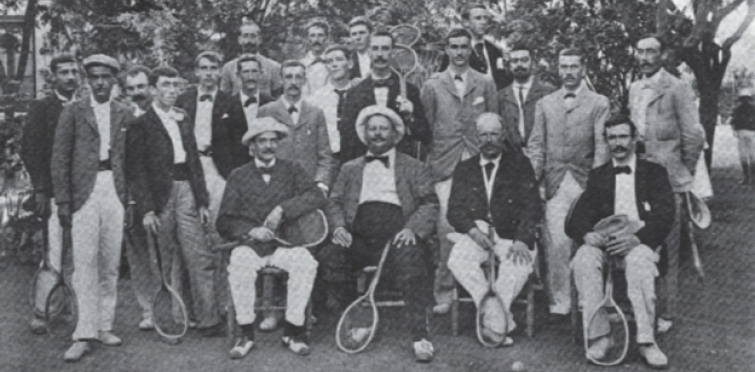Although tennis was introduced in Portugal by the British community living in Lisbon and Porto around 1880, it was disclosed mainly through the efforts of Guilherme Pinto Basto, an icon of the history of Portuguese sport, who seems to have been the one who promoted the first match of the game between Portuguese players, which the few available sources indicate was played in Cascais, probably in the year 1882.
Photo: Athletes in Cascais, in the middle king D. Carlos [june 1899]
Sporting Club de Cascais, the sports and recreation society founded in 1879 and located on the grounds of the former Parada da Cidadela, could then come forth as the birthplace of the sport in Portugal at a time when, thanks to the patronage of kings and D. Luis and D. Carlos, Cascais started to become known as the queen of Portuguese beaches, developing into a privileged test site for the Portuguese to practice this and other sports.
The birth of tennis in our country would have in Guilherme Pinto Basto a notable figure, with known victories between 1882 and 1898 and from 1900 to 1901 in tournaments organized in Cascais in the form of men's singles. Note that even the monarchy would join the new trend, as was reported by the Correio de Cascais in 1901, "His Majesty [the King] has taken part in some tennis matches at Sporting."
Shortly after, even the holding of an international tournament would be announced, "a party in which competed not only the cream of society in Cascais, but many distinguished foreigners, such as the British who purposefully travelled from their country», as was the case of the Wimbledon winner Blanche Hillyard.
Thus, the first International Championships of Portugal were outlined, which officially would take place in the courts of the Sporting Club de Cascais from 1902 and continuously until 1973, except for the years 1910, 1940 and 1951.
In 1919, the Spanish champion Manuel Alonso was the tournament winner in singles, men's pairs and mixed doubles, a feat that he would repeat in 1920 in the former two modalities, keeping the title until 1921 in men's pairs.
A period of intense promotion was then opened, resorting to internationally renowned sportsmen. Amidst this environment, between 1925 and 1929 the International Championships would also be made conspicuous by the participation of Noel Turnbull, who had won the gold medal at the 1920 Olympic Games.
The county of Cascais was about to start a new cycle in its history, following the implementation by Fausto de Figueiredo of a tourism project of international ambition in Estoril, which also had the tennis as a main attraction. In truth, already in 1928 the Casino newspaper would refer to a Tennis Championship being held at the field of Parque Estoril.
The rise of Cascais as a land of tennis would also be evidenced by the creation of a new club dedicated to the practice of the sport, the Estoril Parque Tennis - operational since 1933 in courts in the vicinity of the Spa and Casino -
as well as the organization of the Second Portugal-France (Coastal) Meeting in 1935 under the direction of Joseph Torok. There, also took place the Estoril International Tournament, to which a total renovation of the Estoril courts would succeed, and would be completed around the 1936 International Championship was organized.
New times lay ahead, while the Cascais-Estoril axis became a major tourism center, as it welcomed countless visitors even some monarchs before, during and after the II World War, such as Umberto II of Italy or the Count of Barcelona, who was very fond of a sport that is still one of the brand images of a municipality which continues to honor its pioneer action of having introduced the sport in Portugal.
by João Miguel Henriques
Head of Municipal Archives Division of the Municipality of Cascais

